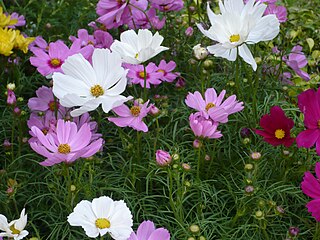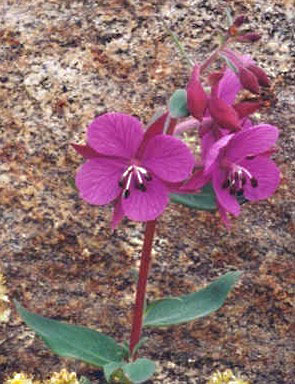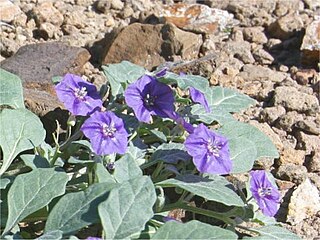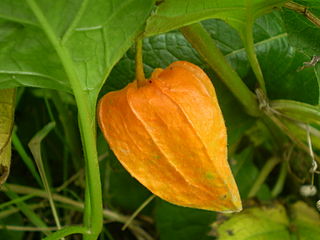
Cosmos is a genus, with the same common name of cosmos, consisting of flowering plants in the sunflower family.

Nolina is a genus of tropical xerophytic flowering plants, with the principal distribution being in Mexico and extending into the southern United States. They are large, dioecious plants.

The Onagraceae are a family of flowering plants known as the willowherb family or evening primrose family. They include about 650 species of herbs, shrubs, and trees in 17 genera. The family is widespread, occurring on every continent from boreal to tropical regions.

Lycium is a genus of flowering plants in the nightshade family, Solanaceae. The genus has a disjunct distribution around the globe, with species occurring on most continents in temperate and subtropical regions. South America has the most species, followed by North America and southern Africa. There are several scattered across Europe and Asia, and one is native to Australia. Common English names for plants of this genus include box-thorn, wolfberry, and desert-thorn. Plants of the World Online currently accepts 101 species.. Other estimates are of 70 to 80 species.

Physalis is a genus of approximately 75 to 90 flowering plants in the nightshade family (Solanaceae), which are native to the Americas and Australasia. At least 46 species are endemic to Mexico. Cultivated and weedy species have been introduced worldwide. A defining feature of Physalis is a large, papery husk derived from the calyx, which partly or fully encloses the fruit. Many species bear edible fruit, and some species are cultivated.

Physalis angulata is an erect herbaceous annual plant belonging to the nightshade family Solanaceae. Its leaves are dark green and roughly oval, often with tooth shapes around the edge. The flowers are five-sided and pale yellow; the yellow-orange fruits are borne inside a balloon-like calyx. The exact native range is uncertain. The species may be naturally endemic to Australia or the Americas or the native range may encompass both the Americas and Australia. It is now widely distributed and naturalized in tropical and subtropical regions worldwide.

Withania somnifera, known commonly as ashwagandha or winter cherry, is an evergreen shrub in the Solanaceae or nightshade family that grows in India, the Middle East, and parts of Africa. Several other species in the genus Withania are morphologically similar.

The plant tribe Phaseoleae is one of the subdivisions of the legume subfamily Faboideae, in the unranked NPAAA clade. This group includes many of the beans cultivated for human and animal food, most importantly from the genera Glycine, Phaseolus, and Vigna.

Nyctaginaceae, the four o'clock family, is a family of around 33 genera and 290 species of flowering plants, widely distributed in tropical and subtropical regions, with a few representatives in temperate regions. The family has a distinctive fruit type called an accessory fruit or anthocarp, and many genera have extremely large pollen grains.

Alternaria is a genus of Deuteromycetes fungi. All species are known as major plant pathogens. They are also common allergens in humans, growing indoors and causing hay fever or hypersensitivity reactions that sometimes lead to asthma. They are present in the human mycobiome and readily cause opportunistic infections in immunocompromised people such as AIDS patients.

Physalis longifolia, known by the common names common groundcherry, longleaf groundcherry, and wild tomatillo, is a species of flowering plant in the nightshade family, Solanaceae. It is native to North America, where it is native to eastern Canada, much of the continental United States, and northern Mexico. It has also been noted as an introduced species in other regions, including parts of the United States outside its native range. In some areas, such as California, it is an occasional noxious weed.

Embelia is a genus of climbing shrubs once placed in the family Myrsinaceae, which is now included in the Primulaceae. There are about 130 species which occur in tropical and subtropical areas across a wide range including Africa and Madagascar and from eastern Asia to the Pacific Islands as well as Australia including:

Melanthera, is a genus of perennial flowering plants in the family Asteraceae, native to North and South America, as well as Africa, Asia and Oceania, including Hawaiʻi.

Quincula is a monotypic genus of flowering plants in the nightshade family, Solanaceae. The sole species it contains, Quincula lobata, is commonly known as Chinese lantern, lobed groundcherry, or purple groundcherry.

Withanolides are a group of at least 300 naturally occurring steroids built on an ergostane skeleton. They occur as secondary metabolites primarily in genera of the Nightshade family, for example in the tomatillo.

Physaleae is a tribe of flowering plants in the subfamily Solanoideae of the family Solanaceae.

Withania coagulans is a plant in the Solanaceae or nightshade family, native to Afghanistan, Pakistan and the Indian subcontinent. Within the genus Withania, W. somnifera (Ashwagandha) and W. coagulans are economically significant, and are cultivated in several regions for their use in Ayurveda. It is claimed to help control diabetes. The berries contain a rennet-like protease that can be used to clot milk for cheese production. The plant is prone to leaf spot disease caused by Alternaria alternata.

The Solanaceae, or the nightshades, are a family of flowering plants that ranges from annual and perennial herbs to vines, lianas, epiphytes, shrubs, and trees, and includes a number of agricultural crops, medicinal plants, spices, weeds, and ornamentals. Many members of the family contain potent alkaloids, and some are highly toxic, but many—including tomatoes, potatoes, eggplant, bell and chili peppers—are used as food. The family belongs to the order Solanales, in the asterid group and class Magnoliopsida (dicotyledons). The Solanaceae consists of about 98 genera and some 2,700 species, with a great diversity of habitats, morphology and ecology.

Alkekengi officinarum, the bladder cherry, Chinese lantern, Japanese-lantern, strawberry groundcherry, winter cherry, alchechengi berry, or Klabuster cherry is a species of flowering plant in the nightshade family Solanaceae. It is a close relative of the new world Calliphysalis carpenteri and a somewhat more distant relative to the members of the Physalis genus. This species is native to the regions covering Southern Europe to South Asia and Northeast Asia.



















